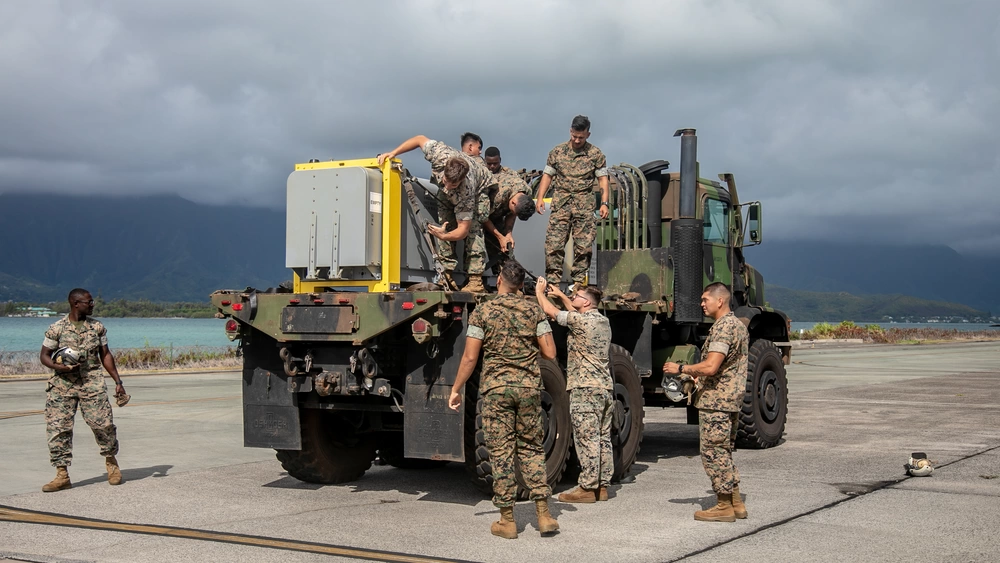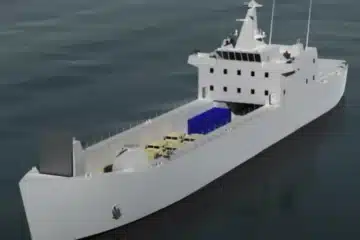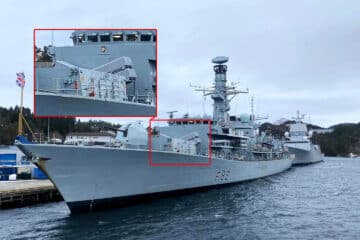In order to cover the “tyranny of distance” problem of hundreds to thousands of miles from the objective(s), attacking nations will require a naval force for amphibious assault. Thus, the USMC is developing Land-based Anti-ship Missile (LBASM) units centered on the 6×6 HIMARS, the Tactical Maritime Tomahawk missile, and the 4×4 JLTV.

“Expeditionary Advanced Base Operations is a form of expeditionary warfare that involves the employment of mobile, low-signature, operationally relevant, and relatively easy to maintain and sustain naval expeditionary forces from a series of austere, temporary locations ashore or inshore within a contested or potentially contested maritime area in order to conduct sea denial, support sea control, or enable fleet sustainment.”
U.S. Marine Corps
One of the key features of EABO and the concept of “USMC Stand-in Forces” (SIF, or rather small groups of Marines prepositioned to wreak havoc on adversary battle plans with stubborn resistance) is the 4×4 Joint Light Tactical Vehicle (JLTV), modified and armed with two stealthy 100+ nautical mile (115-mile or 185 kilometers) Naval Strike Missiles (NSMs). This USMC JLTV armed with two NSM is called the Navy Marine Expeditionary Ship Interdiction System (NMESIS) and provides the U.S. Marines with an unmanned (it can be driven remotely) Anti-Ship Missile capability fired from land. SIFs can position and hide NMESIS JLTVs at various island locations to deny adversaries an unchallenged approach through critical shipping lanes, act as deterrence, or to resist any amphibious invasion.
The over-the-horizon Raytheon sea-skimming stealthy Naval Strike Missile is an improvement over the subsonic Harpoon Anti-Ship missile also in service with the U.S. Navy. The NSM cruises at subsonic speeds of 0.7 to 0.9 Mach and uses advanced passive seekers that can detect enemy sensors and then use evasive maneuvers to stay under or fly around the enemy’s radar coverage. Therefore, NSMs are able to attack heavily defended warships or land targets and also specifically target certain vulnerable sections, such as the ship’s bridge, gun turret, engine room, missile containers, radars, or land vehicles and fortifications to compensate for its small warhead weight.
The Naval Strike Missile costs approximately $2.194 million in FY2021 and weighs 407 kilograms (897 pounds). It has a length of 3.95 meters (13 feet or 156 inches) and carries a 125 kilogram (276 pound) high explosive blast-fragmentation warhead. These dimensions and weights do not include the NSM’s storage missile container.

When employed in EABO and SIF, what makes the USMC NMESIS so troublesome to a potential adversary? A study of the logistics involved in resupplying and rearming NMESIS with spare NSMs can shed some insight on how a JLTV that is remotely-driven, controlled and positioned with NSMs remotely launched can deter enemy ships from conducting their missions. Operated entirely by remote control, NMESIS increases Marine battlefield survivability and can act as elements of surprise in the defense of an island, shore, coast, or battlespace.
Naval News will analyze publicly released photos to show how Naval Strike Missiles are resupplied to USMC JLTV NMESIS via CH-53E/K heavy-lift cargo helicopters, LCAC hovercrafts, MTVR 6×6 trucks, and KC-130J cargo aircrafts. Naval News has discovered through the Defense Visual Information Distribution Service’s (DVIDS) photos that the U.S. Marines are uniquely configured and structured with ground, sea, and air assets to support the NMESIS and its missile logistics resupply as the photos are “proof-positive” that the USMC can indeed accomplish NSM resupply via various means and methods of transportation.

Both the U.S. Army and the U.S. Marines have demonstrated the ability to load a HIMARS 6×6 truck onto a C-130 cargo aircraft for the roll-off/roll-on (RO/RO) tactic of landing, driving into position to launch rockets at enemy targets, and then reloading HIMARS into the C-130 to fly away for true “Shoot-and-scoot.” The JLTV NMESIS can perform the same C-130 RO/RO tactic as HIMARS, only this time the targets will be moving enemy vessels and Anti-Ship missiles will be used instead of rockets.

The new CH-53K “King Stallion” can lift 30% heavier loads (32,000 pounds or 15,900 kilograms) than the CH-53E (27,000 pounds or 12,200 kilograms) for the same 110 nautical mile (204 kilometers) radius as the CH-53E. A CH-53K has demonstrated the ability to hoist a LAV-25A2 so the CH-53s should be able to hoist the JLTV NMESIS (and other JLTV variants) and fly to austere positions to deposit two Naval Strike Missiles where necessary for area sea denial.
The CH-53 can also internally transport a Polaris two or four seat MRZR 4×4 ATV (with or without towing a trailer for the two-seater) for rapid scouting, liaison, command, control, and communications, light defense, and utility tasks. Once disembarked, and with some assembly required, the MRZR can accommodate side-mounted medium machine guns, a four-shot 2.75-inch rocket pod, and even a FLIR ball turret on a pole. U.S. Army tests are being done to make the MRZR drive remotely and unmanned. Thus, the unmanned NMESIS’s Marine crew can be embarked inside the helicopter and conduct remote-control NMESIS operations from afar.
The CH-53K helicopter’s ability to hoist the U.S. Marine reconnaissance LAV-25A2 also aids in the NMESIS deployment because the LAV-25A2 comes with Marine scouts that can hide and position themselves to observe for enemy ship traffic in addition to remote-controlling the NMESIS. The LAV’s 25mm autocannon and 7.62mm coaxial machine gun can provide overwatch and defensive gunfire since the JLTV NMESIS lacks weapons for close-in self-defense. The LAV’s fire controls are passive day and thermal night sights that can aid in scouting and targeting for the NMESIS.

The Amphibious Ready Group, Marine Expeditionary Unit (ARG/MEU) image shows the makeup of the USMC vehicles, hovercrafts, planes, and rotorcraft embarked on a three U.S. Navy ship ARG. This graphic shows the number of landing craft, hovercrafts, MTVRs, HMMWV (to be replaced by JLTVs), CH-53s, and Engineering front loaders required to move and transport the NSM containers to the NMESIS on top of the other pressing logistical demands that the MEU needs to sustain to conduct combat and EABO operations. With the SIF concept, NMESIS can deploy via in-flight tanker refueled KC-130J aircrafts and CH-53 helicopters to INDO-PACOM islands’ ad-hoc runways independent of using the U.S. Navy’s ARG ships.

The vehicle makeup of a MEU isn’t fixed as the theater Combat Commander can modify the MEU to the mission requirements, such as embarking hypersonic missiles trailers and tractors, adding more NMESIS, more HIMARS, more F-35Bs, or more ACVs aboard the three-ship ARG. Furthermore, Expeditionary Sea Bases (ESB), Expeditionary Sea Docks (ESD), Littoral Combat Ships’ Mission Bays (LCS), and the upcoming Light Amphibious Warships (LAWs), can all contribute and transport vehicles, hovercrafts, landing crafts, wheeled front loaders, and rotorcrafts to transport NSM canisters ashore.
The following DVIDS simulation exercise photos show some of the delivery and transportation methods for resupplying NSM canisters to the JLTV NMESIS. In the future, remotely-controlled unmanned vehicles and robotic tractors might prove helpful in replacing Marine muscle in moving the NSM canisters around and on and off helicopters.

Self-contained and secure, a NSM canister on a yellow trailer can travel a long way from the origin to its final destination mounted on an unmanned JLTV NMESIS.


The Marines new CH-53K “King Stallion” heavy-lift helicopter is twelve inches wider (30 centimeters) than the legacy CH-53E “Super Stallion” and thus should allow more room for Marines to maneuver inside. Whereas the legacy CH-53E cannot accommodate an unarmored HMMWV internally, the wider CH-53K can for HMMWV RO/RO tactics.

The above photo shows one NSM on the 6×6 cargo MTVR’s flatbed although the bed’s width hypothetically suggests that perhaps two NSMs can hitch a ride. Note how the light gray NSM canister fits perfectly within the MTVR’s bed dimensions with practically nothing overlapping the truck’s stern.

U.S. Navy and Marine front loaders will prove crucial to lifting the NSM containers onto MTVR trucks and JLTV NMESISs. Currently, there are no plans to mount NSMs on any other vehicle besides the unmanned JLTVs.






